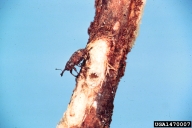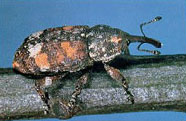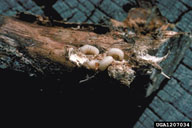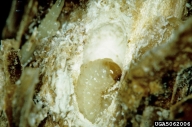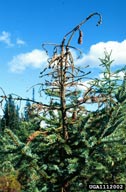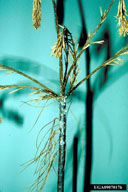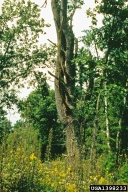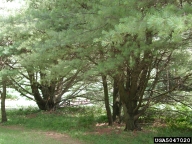White pine weevil
Pissodes strobi (Peck) (Coleoptera: Curculionidae)
Orientation to pest
White pine weevil, Pissodes strobi (Peck), is native to North America. This weevil can breed in a wide range of native and introduced pine and spruce species. Eastern populations attack especially eastern white pine (Pinus strobus L.) and Norway spruce (Picea abies (L.) H. Karst.). In the western United States, Engelmann spruce (Picea engelmanni Hopkins) and Sitka spruce (Picea sitchensis [Bong] Carr.) are attacked. These western populations were formerly felt to be separate species and were studied under the names Pissodes engelmanni Hopkins and Pissodes sitchensis Hopkins, respectively. Cross breeding experiments, however, found all populations to be inter-fertile and thus these western populations were synonymized under the name P. strobi, which is how the name is used here. The important damage by this species is caused by larvae, which tunnel in and kill leaders, inducing branching and crooked trunks. Adults overwinter in the litter and feed on the cambium of the main terminals of their hosts. Eggs are laid in these terminals and larvae feed as cambial borers, often then girdling and killing the terminal. Larvae pupate in chambers made in the woody part of the stem. This species is considered the most serious pest of eastern white pine regeneration. Losses can be very high (up to 40%) to merchantable timber in heavily infested stands over the life of a cohort of trees. Attack is recognized by oozing of pitch from the terminal, followed by wilting and terminal death (and change of color to reddish brown). Signs of former attacks are seen in bushy or crooked tree form. Damage to young white pines may be partially reduced by maintaining a shady over-story of hardwoods, as weevil oviposition is greatest in full sun. Natural enemies are not sufficient to prevent significant losses when silvicultural factors present are favorable to this insect.
Hosts commonly attacked
A variety of native and introduced pines and spruces, especially eastern white (P. strobus), and jack (Pinus banksiana Lamb.) pines and Norway (Picea abies), white (Picea glauca [Moench] Voss), Engelmann (Picea engelmanni), and Sitka (Picea sitchensis) spruce.
Distribution
The white pine weevil is found widely in both the eastern and western United States and Canada, in the ranges of its principal pine and spruce hosts.
Images of white pine weevil
| Figure 1. Adult of white pine weevil Pissodes strobi (top) feeding on terminal; Close up (bottom) of adult | Figure 2. Group of white pine weevil larvae feeding in a stem (top), and close up (bottom) | Figure 3. Leader of spruce (top) killed by white pine weevil; and close up (bottom) of pitch oozing from pine leader fed on by adults of white pine weevil. | Figure 4. Damage to form of pines from white pine weevil injury. Top, old pine with multiple crooked trunks; bottom, bush-like pines with many leaders. |
Important biological control agents related to this pest species
Not surprisingly, given that this native insect has a large geographical range and feeds on several tree genera, a variety of parasitoids and predators have been found associated with white pine weevil brood, including the parasitoids Eurytoma pissodes Girault, Microbracon (now Bracon) pini Muesebeck, Dolichomitus terrebrans nubilipennis (Viereck), Coeloides pissodes (Ashmead), and Allodorus crassigaster (Provancher). The principal predator of importance is Lonchaea corticis Taylor. See Mills and Fischer (1986) for a summary and discussion of white pine weevil natural enemies. However, none of these species reduce populations of white pine weevil to non-damaging levels. Consequently, the concept of introducing new natural enemies from Pissodes species native to Europe was studied (Kennis and Mills, 1994), but no species were ever actually introduced.
Web links for information on white pine weevil
- Fact Sheet | Natural Resources Canada
- Thesis from the Scholars Archive at OSU | Teresa Lysak, Oregon State University
Provides a hazard rating system for white pine weevil risk to Sitka spruce in Oregon, USA - Bulletin | USDA Forest Service, Northeastern Area
Control for Blister Rust and White Pine Weevil
Articles
- Mills, N. J. and P. Fischer. 1986. The entomophage complex of Pissodes weevils, with emphasis on the value of P. validirostris as a source of parasitoids for use in biological control, pp. 297-307. In Roques, A. (ed.). Proceedings of the 2nd Conference on the Cone and Seed insects Working Party, Briancon, France, September 3-5, 1986.
- Kenis, M. and N. J. Mills. 1994. Parasitoids of European species of the genus Pissodes (Col: Curculionidae) and their potential for the biological control of Pissodes strobi (Peck) in Canada. Biological Control 4(1): 14-21.
- Daoust, G. and M. J. Mottet. 2006. Effect of white pine weevil (Pissodes strobi Peck) on plantations of Norway spruce (Picea abies [L.] Karst.). Part 1: Productivity and quality of stems. Forestry Chronicle 82(4): 538-549.
